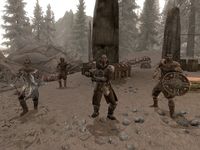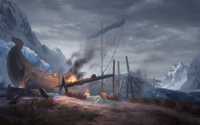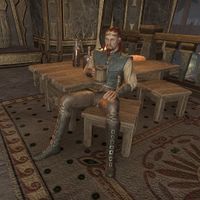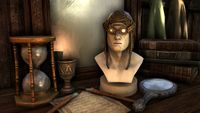Lore:Factions R
Ra Gada[edit]
The Ra Gada (sometimes spelled Ra' Gada or Ra'Gada) was the name given to the Yokudan "Warrior Wave" that left the doomed continent of Yokuda and sailed towards Tamriel. This mass colonization occurred in four successive waves during the eighth and ninth centuries of the First Era, and spanned approximately twenty eight years. The native Orcs, Nedes and Bretons fell to them quickly, as did the various creatures and beasts farther inland. Eventually, they claimed the entire province after only a few major battles and established a new home for the Yokudan people called Hammerfell.
The term Ra Gada became corrupted to Redguard, and although it originally referred only to the warriors of the refugees, it gradually came to be used to refer to the whole race.
Ra'athim[edit]
The Ra'athim Clan (RAH-ah-tim), sometimes stylized as R'Aathim or Raathim, is an ancient family of Chimer (later Dunmer)[nb 1] that hail from the city-state of Ebonheart, in the province of Morrowind. According to the potentially fictional King Edward book series, originally, the Ra'athim Clan were a group of miners with the territory that stretches across the central mainland, but they eventually became the royalty of Ebonheart. Their lineage went on to become the great leaders of both Morrowind and Tamriel. The Empress-Regent, Katariah is one of their most well-known members. In early Morrowind history, the Ra'athim Clan held the High Kingship of Morrowind.
Rageclaw Clan[edit]
The Rageclaw Clan was one of the clans of Reachfolk that lived in the Reach, a region in western Skyrim during the Interregnum in the Second Era. The Reachfolk of the Rageclaw Clan have domesticated a breed of stout, battle-ready bears. These bears are trained from an early age and bound to a specific clansman or clan family. They were a matriarchal society and were known to imitate their animal companions in many ways. The protection of young clan members is of utmost importance. It is not uncommon for entire families within the Rageclaw to go into battle over the slightest threat to their children. They were known for overtaking and absorbing other smaller clans, converting them to the " way of the claw." Women new to the clan enjoy tremendous control and freedom, and often enjoy the transition. Male warriors, on the other hand, are pitted against grown bears in one-on-one combat, forced to earn their place in the clan by forcing an ursine to submit. They are rarely successful, as the trials for those unfamiliar with these massive beasts are often very dangerous.
Ratcatchers Guild[edit]
The Ratcatchers Guild is an officially sanctioned guild. As their name implies, they employ ratcatchers from across the Empire.
During the Akaviri Potentate in 2E 321, Versidue-Shaie gave his approval for the Guild Act, which sanctioned businesses such as the Ratcatchers Guild. They were hence protected by the Empire of Cyrodiil, even into the Third Era, but would be required to pay them if they wanted to expand their influence. The Empire had subsequently strengthened since the Guild Act was passed.
Razorsworn Clan[edit]
Razorsworn Clan is a Dremora clan in service to the Daedric Prince of Destruction, Mehrunes Dagon. They often serve as marauders and assassins and are frequently dispatched to strike at Dagon's enemies in other realms. They are enemies of the Firescourge Clan, whom they view with contempt. In the Second Era, the Razorsworn Clan begrudgingly followed the authority of the Ruinblood Clan. Despite being a Dremora clan, they also had Ruinachs and Havocrels among their ranks.
In 2E 582, one of the Razorsworn-aligned Ruinach, Karzikon was sent to Doomvault Porcixid in Blackwood. Another member, the Havocrel Kothan, was roaming Mehrunes Dagon's realm, the Deadlands.
Reachman Shamans[edit]
Reachman Shamans, also known as Witchmen,[nb 1] are Reachfolk responsible for the spiritual guidance of their clans. Reachfolk approach to religion varies from clan to clan. They worship many spirits, both great and minor. There are many different, yet similar faiths in the Reach. Shamans of different clans follow different traditions, have different beliefs, and are responsible for appeasing and veneration of the different spirits. They often act as religious leaders of their clans.
Reavers[edit]
Reaver is a term used by the Nords of Solstheim to refer to out-islanders, people who inhabit the Sea of Ghosts and raid the northern coasts of Tamriel. These raiders spend most of their time at sea and generally target one-hut settlements and hunting camps, dropping off small raiding parties rather than beaching their ships for fear that their vessels would be stolen or burned.
Gallery[edit]
-
Reavers in the Solstheim ashlands (Dragonborn)
-
A raider's burning longship along the Frozen Coast of Skyrim (ESO)
Notes[edit]
- The term "reaver" is used in other contexts as well. It usually refers to berserkers or individuals who have gone feral.
- Not all Nordic Reavers confined their activities to the northern islands. Certain tales recount the exploits of reavers like Ulgar Stonebeard, who opted to plunder the Reach instead.
See Also[edit]
References[edit]
</noinclude>
Red Exiles[edit]
The Red Exiles were an organization of Ashlanders considered violent and dangerous who were banished by their original tribes, eventually joining together to make their own tribe of outcasts and were counted among the ashlanders that wished for war against the Tribunal Temple. Their territory previously included a camp near Ald’ruhn as well as a position around the daedric ruin of Ashurnabitashpi in Vvardenfell.
Redoran Guard[edit]
The Redoran Guard are the warriors and official military of House Redoran. Though House Redoran has served as the military powerhouse of Dunmer society since before the War of the First Council, the modern incarnation of the Redoran Guard was created during the Oblivion Crisis, to combat Mehrunes Dagon's invasion after the withdrawal of the Imperial Legions from Morrowind. Afterward, the Redoran Guard were chiefly, if not solely responsible for the halting of the Argonian Invasion in 4E 6 and have served as the protectors of Morrowind and the Dunmer since. The Guard has postings throughout Morrowind, including the settlement of Raven Rock and the city of Mournhold. In 4E 95, the Redoran Guard of Raven Rock under Captain Modyn Veleth successfully prevented an assassination attempt on Councilor Lleril Morvayn at the hands of Vilur Ulen of the disgraced former Great House Hlaalu. In 4E 201 they assisted the Last Dragonborn in thwarting a second plot by Vilur's son Vendil, and most of the Mournhold garrison was reassigned to other less secure regions of Morrowind.
Red Sabre[edit]
A fleet of pirates formed during the Camoran Usurper, under the leadership of Torradan ap Dugal. Destroyed by Commodore Fasil Umbranox of the Imperial Navy around 3E 286.[1]
Remnants[edit]
The Remnants, also known as the Eyes that Watch, are a Redguard network of warriors and spies from Hammerfell that operate in Skyrim and elsewhere. Their main purpose is to make sure the Aldmeri Dominion and the Thalmor follow the terms and conditions set forth by the Second Treaty of Stros M'Kai, after their retreat from Hammerfell. To that end, they have agents stationed in Skyrim to keep an eye on the Thalmor.
Remnants Clan[edit]
The Remnants Clan (or Remnant Clan, also called the Remnants of Apocrypha or simply the Remnants) is an organization of Dremora in service to Hermaeus Mora, once sworn to defend Apocrypha. They are based in the Cenotaph. Unlike most Dremora, the Remnants reject the hierarchical structures common to their kind and have a completely synchronized organization with no ranks or leaders. The order sees themselves as protectors of knowledge, and they often steal artifacts, tomes, and other objects being researched that they deem too powerful for others.
Renrijra Krin[edit]
The Renrijra Krin (which translates as The Mercenary's Grin, The Laugh of the Landless or The Smiling Scum, and is often shortened to Renrijra) are a long-standing Khajiiti criminal organization. The Renrijra Maor (also called the Renrijra Pirates) are a naval subgroup of the organization.
The Renrijra's name reflects the group's philosophy of bravery and enjoyment of life, while also indicating that they owe allegiance to no ruler. It was originally a derogatory term, but was adopted by the amused group. The organization has no fixed rules, preferring to call its tenets "thjizzrini", or "foolish concepts". Their ranks are made up of thieves, thugs, bandits, smugglers, pirates and saboteurs. They are ruthless in pursuing their aims, but depend on guerrilla tactics to operate, giving freely to Khajiit civilians in return for their support.
During the Alliance War, the Renrijra Maor were hired by the Aldmeri Dominion as privateers. They raided the coast of Glenumbra, seeking to conquer the shores, which elicited an attack by the Breton Navy. In 2E 582, they began operating along the western coast of Morrowind and Black Marsh. They attempted to enslave the Argonian population of Silent Mire, a village in Deshaan, but were driven off by a series of counter strikes. They were also responsible for helping to supply the failed Dominion invasion of Shadowfen, but changed allegiance to the local pirate boss Captain One-Eye after their leader was killed.
By the late Third Era, the Renrijra had proclaimed dedication to reclaiming areas of Cyrodiil that they saw as rightfully belonging to Elsweyr. They blamed the Count of Leyawiin for driving the Khajiit from the fertile land around Lake Makapi and the River Malapi. In this they disagree with their ruler, the Mane, who was responsible for making the agreement with Cyrodiil. However, it was the belief of the Empire that the organization was simply posing as freedom fighters in order to further their criminal agenda and their Cyrodilic Skooma smuggling. In 3E 433, Special Inquisitor Drels Theran of Bravil was in charge of suppressing the Renrijra insurgents.
Resolutes of Stendarr[edit]
The Resolutes of Stendarr are a group of Stendarr devotees who have sworn to help the sick and protect the weak. The Resolutes consist of holy warriors and individuals who are talented in healing magicks. Their healers are encouraged by their leaders to use those magicks unsparingly. The Resolutes of Stendarr wears silver pins to identify themselves as members of the organization.
The Resolutes seek to hunt what they call the Four Abominations: Daedra, manbeasts, vampires and risen corpses. The Resolutes hold that these abominations are unnatural, and seek to drive them from Tamriel in Stendarr's name. The Four Abominations abhor the light; thus the Resolutes believe that Stendarr gifted those who invoke his name with the ability to clothe themselves in an aura of blessed light. The Resolutes hold that Stendarr's faithful have adapted the gift of light to smite their enemies, as well as defend and heal their allies.
Resolution of Z'en[edit]
The Resolution of Z'en (also called the Resolution of Zenithar) is the temple dedicated to Zenithar the Provider, God of Work and Commerce. These are generally the place of worship for Zenithar. The Resolution was designed to be adaptable with the current times, but resilient to its unforgiving nature, hence the name. Instead of charity and indulgence, the Resolution favors skill in speechcraft and the arts of mercantilism. The Knights of Iron are the Resolution's militant arm, but they are enemies of the Benevolence of Mara. In the Iliac Bay, the Resolution of Z'en has many chapters, including Gavaudon, Glenpoint, Kairou, Kambria, and Totambu.
Restless League[edit]
The Restless League was a group of Redguard pirates based out of a hidden cove near Stros M'Kai. The League played a critical role in the uprising there during 2E 864. Their leader was a man named Basil; other prominent members included Iszara and later her brother Cyrus. The League used the lighthouse in Saintsport as a signal for members to receive transport to their hideout.
Rim-Men[edit]
The Rim-Men (also known as the Rimmen) are a group of Imperials that live across the Rim Territories in the province of Elsweyr. The Rim-Men descended from Imperial retainers that worked and later intermingled with the Tsaesci that served the Second Empire of Cyrodiil. These refugees fled the Imperial City following the death of Savirien-Chorak in 2E 431 and the ascension of the warlord Attrebus during the Interregnum. They live in isolation from the rest of Elsweyr and practice the culture that comes from their ancestral homeland of Akavir such as the Proving Festival or the belief that waterways connect to the realm of the dead.
Ring of Daggers[edit]
The Ring of Daggers, sometimes known as the Daggers, is the secret intelligence network of the Daggerfall Covenant.
River-Elk Clan[edit]
The River-Elk Clan was a prominent clan of Reachfolk that lived in the Reach, a region in western Skyrim during the Interregnum in Second Era. The River-Elks were strong in number and inhabited a multitude of semi-permanent camps throughout the Karth Valley. Although they were distrustful of the foreign way, they willingly engaged in trade with foreigners, provided they proven themselves to be friends to the clan.
River Horse Bretons[edit]
The Bjoulsae River Tribes (also known as the Horse-People of the Bjoulsae River, the River Horse Bretons, or simply the horsemen) are the indigenous groups of tribal Bretons that live in the Bjoulsae River region. While information on them is scarce, the horsemen are a nomadic, primitive folk that wear fur armor, bone necklaces, and turbans. As the name suggests, they are known for their horses. Their battle strategies and tactics are described as straight-forward, which is the "way of the horse men", in the book The Mirror.
Roister's Club[edit]
The Roister's Club was an organization responsible for management of all aspects of Tales of Tribute, such as organizing tournaments, producing new rules, sponsoring chapters, and manufacturing cards. In the beginning, the Roister's Club was a small group of only a few dozen people who created the game. Although originally only the game's creators were members of the club, it has grown to the point that almost everyone who played the game identified as a Roister.
As time passed, the game's original creators, who were mostly scholars, artisans, and explorers, began to be referred to as the Founders. While they were known for valuing their anonymity, they still played an active role in promoting the game.
Root-Whisper Tribe[edit]
The Root-Whisper Tribe is an Argonian tribe that resided in the Deepmire of Murkmire. Long ago, the tribe's Hist willed them to build the Vakka-Bok Xanmeer to collect sunlight. The tribe's religious leaders opposed Duskfall. The tribe's known leaders included a raj-kaal and a sap-speaker.
Rourken[edit]
The Rourken were a clan and house of Dwemer that lived in the wastes of Hammerfell. The Rourken are most well-known for their exodus from Morrowind, after the formation of First Council between the Chimer and the Dwemer. In legend, the Rourken Chieftain grasped his mighty warhammer, Volendrung and cast it to the far west, where he and his people would rebuild. The hammer is seen as a family symbol for Clan Rourken. Their capital city is known as Volenfell, which translates to the "City of the Hammer" in Dwemeris. It is located in the vast expanse of the Alik'r Desert, however accounts vary on its specific location, either in the Gilane region, or in the mountains southeast of Satakalaam.
Royal Guard[edit]
The Royal Guard are private guards for the Royalty of Morrowind and other regions of Monarchy rule. They operate separately from both the Imperial Legion and the Ordinators, and can mainly be found in or around Mournhold. During the rule of King Hlaalu Helseth it was led by an Imperial man Tienius Delitian, the chief of security.
Their armored uniform is a medium set of red plates/purple chainmail with galea style visors, while their non-armor house uniform is a simple black cloak, dark red sun tunic, and breeches.
Royal Imperial Mananauts[edit]
The Royal Imperial Mananauts are a scholarly organization that operates under the Elder Council. Their exact duties are unclear, but the treatise The Hierarchical Structure of the Greater Dremora was written by a Royal Imperial Mananaut named Secundius based on observations of Oblivion gleaned from the scrying chambers beneath the Imperial Palace. They were active from the Second Era to at least the end of the Third Era.
They are considered the last remaining legacy of the Imperial Mananauts, who operated under the reign of the Reman Dynasty in the late First Era. Similarly to the Sun Birds of Alinor, the Mananauts undertook expeditions across the Void to enter Aetherius by way of the stars. In their cosmic ventures, they discovered that mortal minds must be acclimated to Oblivion by gentle degrees to prevent mental distortion. To remedy this issue, they utilized Slipstream Realms, points within the Aurbis where truths can co-exist without conceptual abrasion. These expeditions required prohibitively large amounts of magicka, however, and as with the Sun Birds, the Mananauts were eventually dissolved.
Ruddy Fangs[edit]
The Ruddy Fangs are a Khajiit bandit pride from Elsweyr. They have the biggest presence near the Scar of Anequina, but are a scourge upon all of Elsweyr. Their main source of income is smuggling things to and from Elsweyr, and one of their biggest products is Skooma. Joining the Ruddy Fangs require you to throw out any morals, and the only way to get out of the business is death.
Rune Knights of the Purgatory Disquisition[edit]
The Rune Knights of the Purgatory Disquisition (or the rune knights of old) were a small and extremely secretive knightly order founded early on during the Second Era. They were established by an obscure patron and traveled from Apocrypha to wage battles across Nirn. It was speculated by some that this founder could've been a Daedra or powerful arcanist. The order seemingly didn't last long but managed to leave a footprint on arcanist spellcasting, perfecting runic warding techniques which remained unchanged in the modern arcanist's skill-set. Azandar al-Cybiades was known to research the rune knights of old, but he referred to the result of his studies as a "little more than curious, open ended ephemera".



